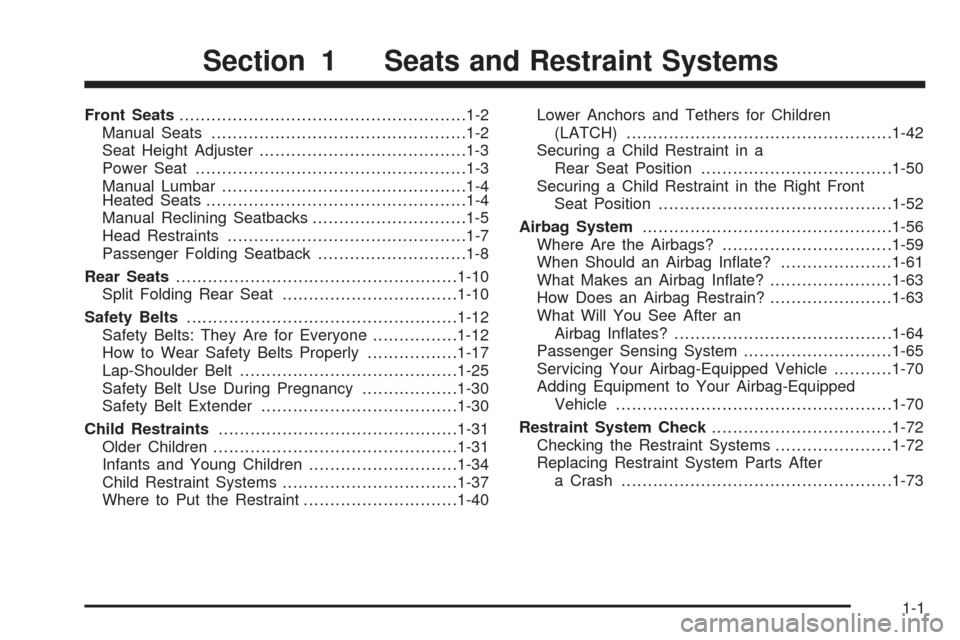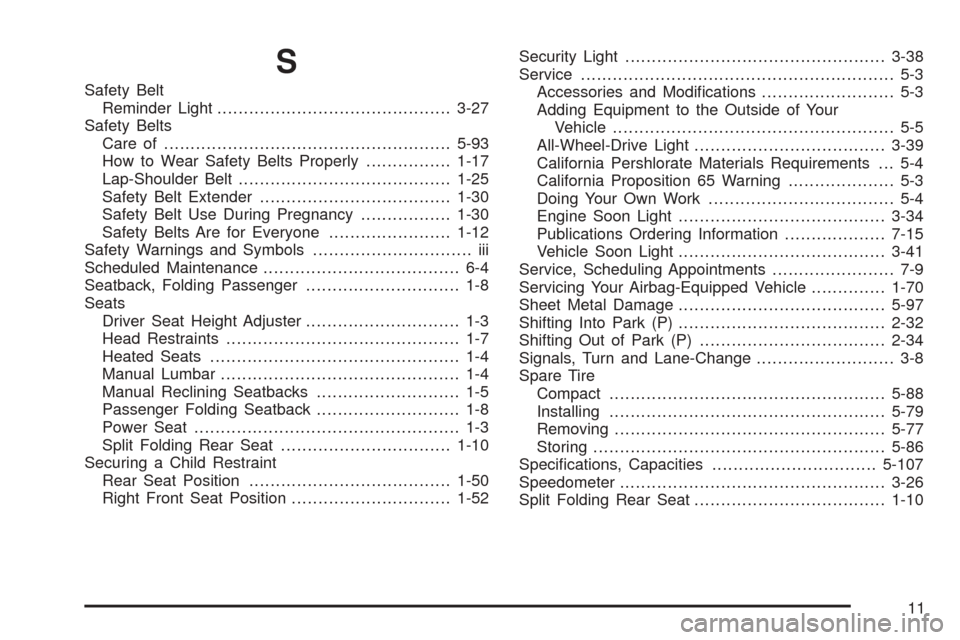2008 CHEVROLET EQUINOX fold seats
[x] Cancel search: fold seatsPage 5 of 436

Front Seats......................................................1-2
Manual Seats................................................1-2
Seat Height Adjuster.......................................1-3
Power Seat...................................................1-3
Manual Lumbar..............................................1-4
Heated Seats.................................................1-4
Manual Reclining Seatbacks.............................1-5
Head Restraints.............................................1-7
Passenger Folding Seatback............................1-8
Rear Seats.....................................................1-10
Split Folding Rear Seat.................................1-10
Safety Belts...................................................1-12
Safety Belts: They Are for Everyone................1-12
How to Wear Safety Belts Properly.................1-17
Lap-Shoulder Belt.........................................1-25
Safety Belt Use During Pregnancy..................1-30
Safety Belt Extender.....................................1-30
Child Restraints.............................................1-31
Older Children..............................................1-31
Infants and Young Children............................1-34
Child Restraint Systems.................................1-37
Where to Put the Restraint.............................1-40Lower Anchors and Tethers for Children
(LATCH)..................................................1-42
Securing a Child Restraint in a
Rear Seat Position....................................1-50
Securing a Child Restraint in the Right Front
Seat Position............................................1-52
Airbag System...............................................1-56
Where Are the Airbags?................................1-59
When Should an Airbag In�ate?.....................1-61
What Makes an Airbag In�ate?.......................1-63
How Does an Airbag Restrain?.......................1-63
What Will You See After an
Airbag In�ates?.........................................1-64
Passenger Sensing System............................1-65
Servicing Your Airbag-Equipped Vehicle...........1-70
Adding Equipment to Your Airbag-Equipped
Vehicle....................................................1-70
Restraint System Check..................................1-72
Checking the Restraint Systems......................1-72
Replacing Restraint System Parts After
a Crash...................................................1-73
Section 1 Seats and Restraint Systems
1-1
Page 14 of 436

Rear Seats
Split Folding Rear Seat
The rear split bench seatbacks have three available
positions — folded forward, upright, or partially reclined.
Both of the seatbacks can be moved to any of the
three positions independent of the other seatback
position. The rear bench seat can also be moved
forward and rearward.
{CAUTION:
If the seatback is not locked, it could move
forward in a sudden stop or crash. That could
cause injury to the person sitting there. Always
push and pull on the seatback to be sure it is
locked.
{CAUTION:
A safety belt that is improperly routed, not
properly attached, or twisted will not provide
the protection needed in a crash. The person
wearing the belt could be seriously injured.
After raising the rear seatback, always check
to be sure that the safety belts are properly
routed and attached, and are not twisted.
1-10
Page 265 of 436

{CAUTION:
Do not load your vehicle any heavier than
the Gross Vehicle Weight Rating (GVWR),
or either the maximum front or rear Gross
Axle Weight Rating (GAWR). If you do,
parts on your vehicle can break, and it
can change the way your vehicle handles.
These could cause you to lose control and
crash. Also, overloading can shorten the
life of your vehicle.
Notice:Overloading your vehicle may cause
damage. Repairs would not be covered by your
warranty. Do not overload your vehicle.
If you put things inside your vehicle — like
suitcases, tools, packages, or anything else — they
will go as fast as the vehicle goes. If you have to
stop or turn quickly, or if there is a crash, they will
keep going.
{CAUTION:
Things you put inside your vehicle can
strike and injure people in a sudden stop
or turn, or in a crash.
Put things in the cargo area of your
vehicle. Try to spread the weight
evenly.
Never stack heavier things, like
suitcases, inside the vehicle so that
some of them are above the tops of
the seats.
Do not leave an unsecured child
restraint in your vehicle.
When you carry something inside the
vehicle, secure it whenever you can.
Do not leave a seat folded down
unless you need to.
4-27
Page 393 of 436

Maintenance Footnotes
(a)Visually inspect brake lines and hoses for proper
hook-up, binding, leaks, cracks, chafing, etc. Inspect
disc brake pads for wear and rotors for surface
condition. Inspect other brake parts, including calipers,
parking brake, etc. Check parking brake adjustment.
(b)Visually inspect front and rear suspension and
steering system for damaged, loose, or missing parts or
signs of wear. Visually check constant velocity joints,
rubber boots, and axle seals for leaks. With 3.4L
V6 engine: Inspect electric power steering cables for
proper hook-up, binding, cracks, chafing, etc. With 3.6L
V6 engine: Inspect hydraulic power steering lines and
hoses for proper hook-up, binding, leaks, cracks,
chafing, etc.
(c)Visually inspect hoses and have them replaced if
they are cracked, swollen, or deteriorated. Inspect
all pipes, fittings and clamps; replace with genuine parts
as needed. To help ensure proper operation, a pressure
test of the cooling system and pressure cap and cleaning
the outside of the radiator and air conditioning condenser
is recommended at least once a year.(d)Inspect wiper blades for wear, cracking, or
contamination. Clean the windshield and wiper blades, if
contaminated. Replace wiper blades that are worn or
damaged. See Windshield Wiper Blade Replacement on
page 5-50andWindshield and Wiper Blades on
page 5-95for more information.
(e)Make sure the safety belt reminder light and safety
belt assemblies are working properly. Look for any
other loose or damaged safety belt system parts. If you
see anything that might keep a safety belt system
from doing its job, have it repaired. Have any torn or
frayed safety belts replaced. Also see Checking the
Restraint Systems on page 1-72.
(f)Lubricate all key lock cylinders, hood latch
assemblies, secondary latches, pivots, spring anchor
and release pawl, hood and door hinges, rear folding
seats, and liftgate hinges. More frequent lubrication may
be required when exposed to a corrosive environment.
Applying silicone grease on weatherstrips with a clean
cloth will make them last longer, seal better, and not stick
or squeak.
(g)If you drive regularly under dusty conditions, the
filter may require replacement more often.
6-7
Page 433 of 436

S
Safety Belt
Reminder Light............................................3-27
Safety Belts
Care of......................................................5-93
How to Wear Safety Belts Properly................1-17
Lap-Shoulder Belt........................................1-25
Safety Belt Extender....................................1-30
Safety Belt Use During Pregnancy.................1-30
Safety Belts Are for Everyone.......................1-12
Safety Warnings and Symbols.............................. iii
Scheduled Maintenance..................................... 6-4
Seatback, Folding Passenger............................. 1-8
Seats
Driver Seat Height Adjuster............................. 1-3
Head Restraints............................................ 1-7
Heated Seats............................................... 1-4
Manual Lumbar............................................. 1-4
Manual Reclining Seatbacks........................... 1-5
Passenger Folding Seatback........................... 1-8
Power Seat.................................................. 1-3
Split Folding Rear Seat................................1-10
Securing a Child Restraint
Rear Seat Position......................................1-50
Right Front Seat Position..............................1-52Security Light.................................................3-38
Service........................................................... 5-3
Accessories and Modi�cations......................... 5-3
Adding Equipment to the Outside of Your
Vehicle..................................................... 5-5
All-Wheel-Drive Light....................................3-39
California Pershlorate Materials Requirements . . . 5-4
California Proposition 65 Warning.................... 5-3
Doing Your Own Work................................... 5-4
Engine Soon Light.......................................3-34
Publications Ordering Information...................7-15
Vehicle Soon Light.......................................3-41
Service, Scheduling Appointments....................... 7-9
Servicing Your Airbag-Equipped Vehicle..............1-70
Sheet Metal Damage.......................................5-97
Shifting Into Park (P).......................................2-32
Shifting Out of Park (P)...................................2-34
Signals, Turn and Lane-Change.......................... 3-8
Spare Tire
Compact....................................................5-88
Installing....................................................5-79
Removing...................................................5-77
Storing.......................................................5-86
Speci�cations, Capacities...............................5-107
Speedometer..................................................3-26
Split Folding Rear Seat....................................1-10
11